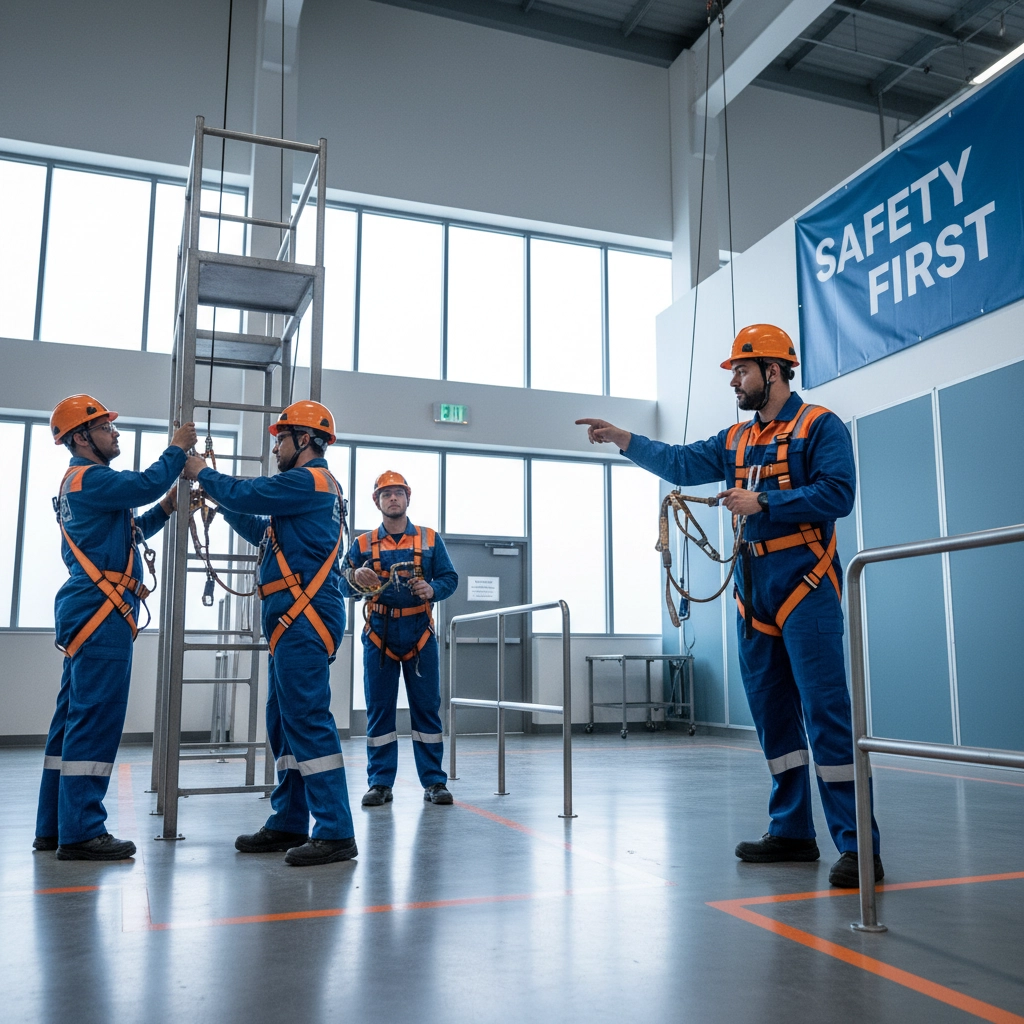
Workplace safety training failures expose businesses to substantial financial risks that extend far beyond immediate accident costs. Inadequate training programs can result in catastrophic expenses including OSHA penalties, lawsuit settlements, workers' compensation claims, operational shutdowns, and significantly increased insurance premiums. Understanding these critical training mistakes enables business leaders to implement comprehensive safety protocols that protect both employees and organizational financial stability.
Mistake 1: Treating Safety Training as a One-Time Event
Many organizations approach safety training as a compliance checkbox rather than an ongoing operational necessity. This fundamental error creates substantial liability exposure as employees lose retention of critical safety protocols over time, equipment specifications change, and new workplace hazards emerge.
The financial consequences of one-time training approaches compound significantly when accidents occur months after initial instruction. Regulatory investigators and legal professionals routinely examine training frequency and recency during accident investigations. When evidence reveals that employees received safety instruction only during initial orientation, organizations face enhanced penalties for failing to maintain current safety competencies.
Workers who do not receive regular safety refresher training demonstrate measurably higher accident rates compared to those participating in continuous training programs. A single serious workplace injury resulting from outdated safety knowledge can generate hundreds of thousands of dollars in medical expenses, legal fees, regulatory penalties, and potential criminal liability charges.
Recommended Action: Establish quarterly safety training reviews with annual comprehensive recertification programs. Document all training activities with detailed records of participant attendance, competency demonstrations, and knowledge assessments.

Mistake 2: Using Generic, One-Size-Fits-All Programs
Standardized safety training programs fail to address industry-specific hazards and workplace-specific risks that characterize individual business operations. Generic training materials cannot adequately prepare employees for the particular safety challenges they encounter in their specific work environments.
This approach becomes financially devastating when accidents occur in situations that generic training never addressed. Regulatory agencies and legal professionals exploit this training inadequacy during investigations, demonstrating that organizations failed to provide relevant safety instruction for known workplace hazards.
Different industries present distinct safety risks ranging from fire hazards and electrocution dangers to chemical exposure and work-at-height situations. When safety training fails to address these industry-specific concerns, organizations face multiplied penalties and enhanced legal liability.
Recommended Action: Conduct comprehensive workplace hazard assessments to identify specific risks within your operations. Develop customized training programs that directly address identified hazards with detailed response procedures and equipment-specific safety protocols.
Mistake 3: Failing to Engage Employees Through Interactive Training
Passive training methods that rely on lectures, videos, or written materials without hands-on practice create employees who cannot effectively respond to actual emergency situations. Disengaged training participants retain significantly less safety information and demonstrate poor decision-making capabilities during real hazardous events.
Interactive training elements including practical demonstrations, equipment handling exercises, and emergency response simulations provide employees with experiential learning that translates directly into effective workplace safety behaviors. Organizations that rely solely on passive training methods face substantial liability when accident investigations reveal inadequate skill development.
The financial impact manifests when legal proceedings demonstrate that employees were technically "trained" but could not demonstrate actual competency in safety procedures. This evidence of inadequate training methodology can void insurance coverage provisions and expose executives to personal liability charges.
Recommended Action: Incorporate hands-on training components including equipment operation practice, emergency response drills, and safety procedure demonstrations. Require employees to demonstrate practical competency through skills assessments rather than written tests alone.

Mistake 4: Insufficient Training Depth and Frequency
Superficial safety training programs that cover broad topics without detailed instruction leave employees unprepared for complex safety challenges. Inadequate training depth particularly affects critical areas such as incident analysis, emergency response procedures, and equipment-specific safety protocols.
Organizations often underestimate the comprehensive instruction required for effective workplace safety. Minimal training investment creates maximum liability exposure when serious accidents occur. Forensic investigators can demonstrate direct causation between insufficient training and accident severity, creating liability that often exceeds available insurance coverage.
Insufficient training frequency compounds these risks as safety knowledge degrades over time without reinforcement. Employees who receive comprehensive initial training but no follow-up instruction demonstrate declining safety performance that increases accident probability substantially.
Recommended Action: Develop comprehensive training curricula that provide detailed instruction on specific safety procedures, equipment operation, and emergency response protocols. Implement monthly safety training sessions with role-specific instruction based on individual job responsibilities.
Mistake 5: Poor Follow-Up and Reinforcement Systems
Training effectiveness requires ongoing reinforcement through follow-up sessions, performance monitoring, and skill validation activities. Organizations that provide initial training without subsequent reinforcement create knowledge gaps that contribute directly to workplace accidents.
Continuous learning and practice ensure long-term retention and practical application of safety procedures. When accident investigations reveal that employees had initial training but received no reinforcement despite clear evidence of skill degradation, courts typically view this as corporate negligence warranting punitive damages.
The absence of follow-up training systems prevents organizations from identifying and correcting dangerous knowledge gaps before accidents occur. This systematic failure to maintain safety competencies creates enhanced legal liability that can result in damage awards exceeding compensatory amounts.
Recommended Action: Establish systematic follow-up training schedules with documented performance assessments. Implement peer observation programs and supervisor safety coaching to provide ongoing reinforcement of critical safety procedures.

Mistake 6: Lack of Evaluation and Feedback Mechanisms
Organizations that fail to measure training effectiveness cannot identify knowledge gaps or training deficiencies that contribute to workplace accidents. Without evaluation systems, businesses operate with false confidence in training programs that may be fundamentally inadequate.
Ignoring employee feedback about training quality and relevance eliminates valuable insights about program weaknesses. When accidents occur and investigations reveal that employees had previously identified training inadequacies that management ignored, resulting liability often includes charges of willful misconduct that insurance policies specifically exclude.
Effective evaluation systems include both quantitative assessments of knowledge retention and qualitative feedback about training relevance and effectiveness. Organizations without these measurement capabilities cannot demonstrate due diligence in safety training provision.
Recommended Action: Implement comprehensive training evaluation systems including pre- and post-training assessments, employee feedback surveys, and performance observation protocols. Use evaluation results to continuously improve training content and delivery methods.
Mistake 7: Rushing Through Training Processes
Accelerated training schedules that prioritize completion over comprehension create employees with superficial safety understanding. Rushed training participants develop inadequate skills that affect their ability to recognize hazards and implement appropriate safety measures.
Time pressures that force employees to rush through training materials prevent thorough skill development and comprehensive understanding of safety procedures. This rushing mentality extends beyond training sessions, creating workplace attitudes that ignore important safety precautions during daily operations.
Rushed training results in regulatory noncompliance and creates vulnerable attitudes toward workplace safety that become highlighted during regulatory inspections. When violations compound with accident investigations, financial penalties escalate substantially, often forcing business closure through accumulated fines and legal costs.
Recommended Action: Allocate sufficient time for comprehensive safety training without production pressures or deadline constraints. Establish training standards that prioritize thorough understanding and skill development over rapid completion.
Financial Impact and Risk Management
These training mistakes create cascading financial consequences that extend far beyond immediate accident costs. Poor safety training leads to increased workers' compensation claims, higher insurance premiums, regulatory penalties, and potential punitive damages that can permanently impair business operations.
Organizations must recognize that comprehensive safety training represents essential business protection rather than optional expense. Effective training programs reduce liability exposure, lower insurance costs, improve regulatory compliance, and create workplace cultures that prevent costly accidents.
Recommended Action: Conduct immediate assessments of current safety training programs to identify potential deficiencies. Consult with safety professionals and insurance representatives to develop comprehensive training strategies that address specific organizational risks and regulatory requirements.
For businesses seeking to strengthen their safety training programs and reduce liability exposure, professional guidance ensures compliance with current regulations and industry best practices. Contact qualified safety consultants and insurance professionals to develop customized training solutions that protect both employees and organizational financial stability.

